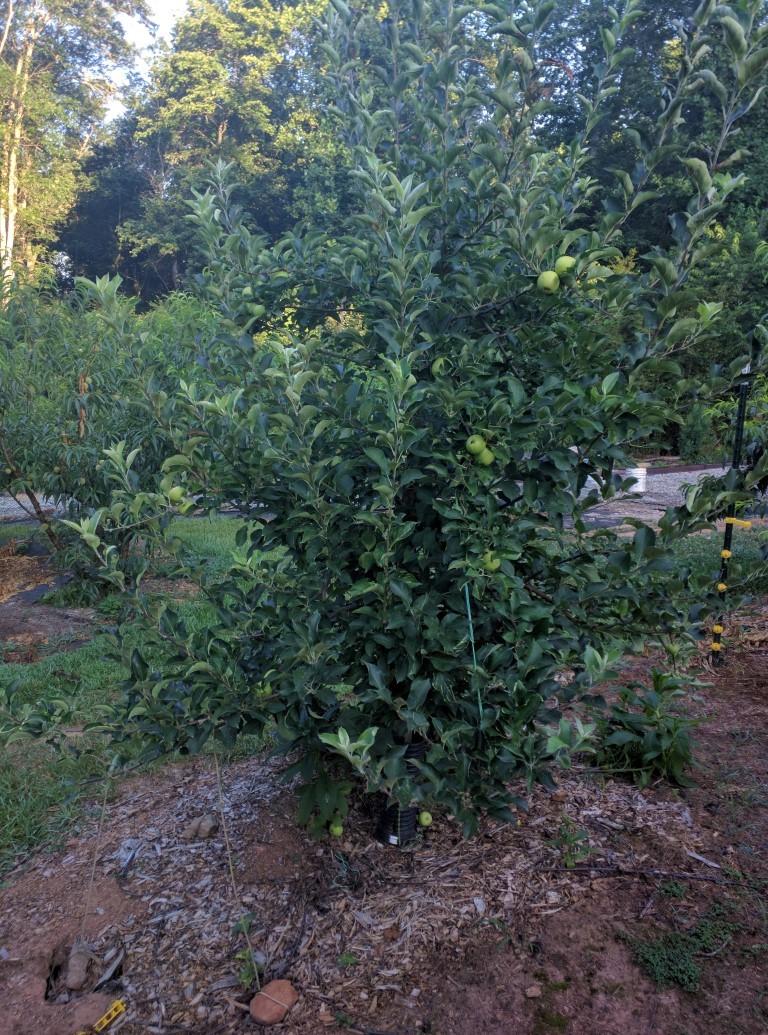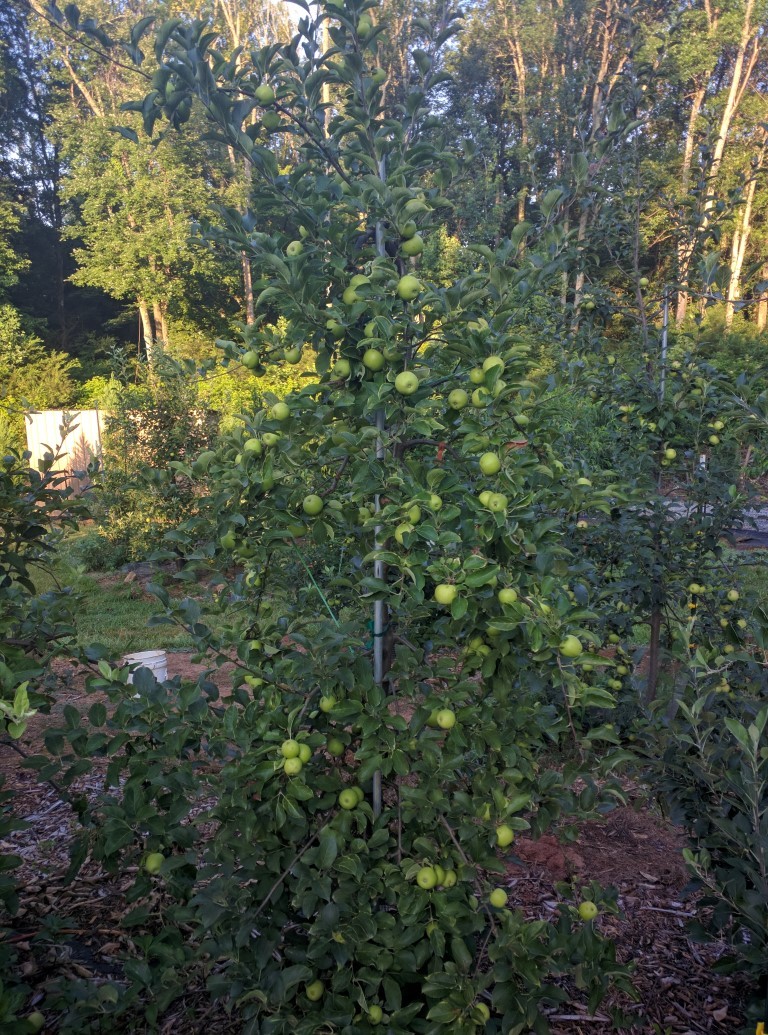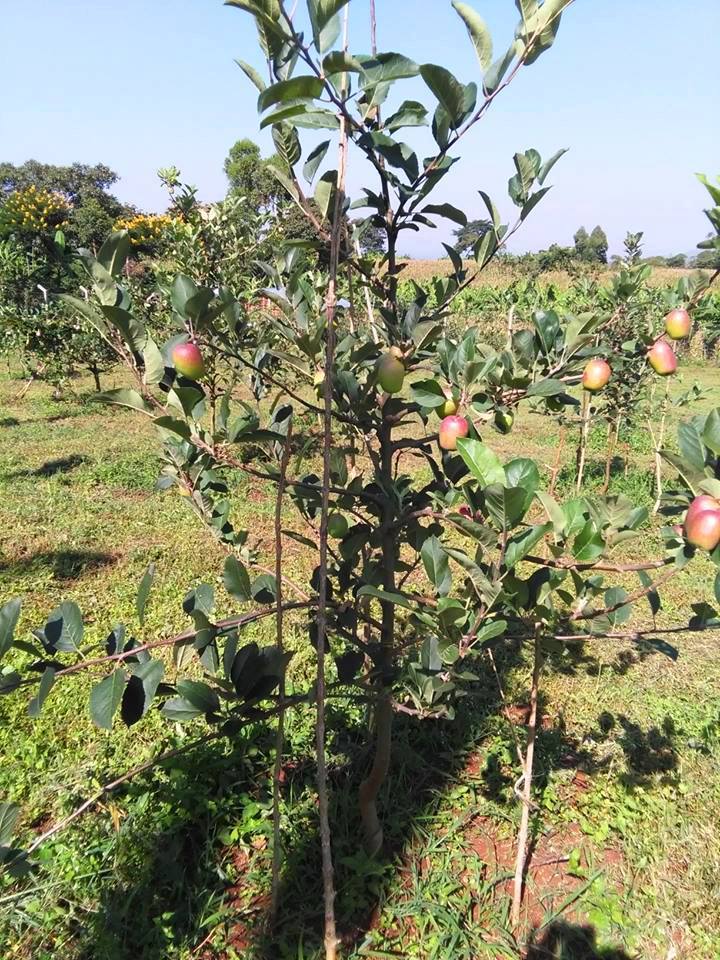Below are pictures of a 5 year old Goldrush planted on M-111 and a 4 year old Goldrush on G-11 taken about a week ago. The Goldrush on G-11 has been overall the most productive tree in my orchard in my 5 years of growing apples and just keeps cranking out great crops even though it may be under thinned. The M-111 is larger tree but has half the apples of the G-11 tree or less. I probably have not done enough limb bending on the M-111 so it is at least partly my fault the M-111 is not more productive but I am starting to wonder if or when will the M-111 tree production catch up to the G-11.
When I grew Apples in the Austin Texas area I had a few trees on M111 and they never produced much in the six or so years I had them. One of them a Fuji never made a single apple and bareley even flowered. I knew of others who had similar looong periods of no good production as well. I just think its a waste of time for these slow to bear varieties whether its rootstock or scion. So hopefully your m111 tree catches up soon but man that G11 looks awesome!
The branch angle does make a huge difference in bearing; your M111 is in a runaway vegetative state right now and is getting too tall because of it. It also looks like some of the branches are pretty thick, and need removing. Because the G-11 started bearing so early, the crop load pulled the branches down for you, enhancing the productivity.
If you ever want the M111 to reach its full potential, thin a third of those branches out right now so more light will hit the other branches, and tie them down to horizontal or below with hooks of rebar tie wire. This will greatly change the nature of the tree to a calm, productive habit.
The M111 will catch up with the G-11 when the zip ties on that post break and the wind uproots the G-11 two weeks before harvest.
I pruned outward and bent limbs down on my m111 trees. This is the fourth year for them and a very heavy set on them. I thinned very vigorously and am very pleased with crop, plus no worries about trees falling over. So I would defenetly agree get those limbs close to horizontal and they will fruit. I should add to this that mine are pruned open center, don’t know if that makes any difference on how soon they fruit, but I would suspect it helps due to the amount of sunlight getting to the limbs
Works great for apples and pears. I started doing the bending about three years ago and now I’m starting to see the results in more flowering and fruit.
Yes I have a couple of pears on ac harrow sweet that was just planted last year. Limbs are pretty much horizontal. I was very suprised when it flowered.
I don’t know the answer about the M111, but I would also suggest that Goldrush on G11 has been a superstar in my orchard. They don’t always completely ripen, so I can’t say that I’m as blown away by the fruits as I would have expected, but mine produce every year whether I’ve properly thinned them the previous year or not and they’re loaded again this year in their 5th leaf or so.
I agree with Applenut that tree looks like a bush not a tree. M111 is in the upper end of semi dwarf. You are going to be doing a lot of fighting with it to keep it short and productive if that was your wish. I would expect that M111 to way out produce the G11 if you allow it to become a tree.
But it can be done, this GoldRush on M111 is five years old. It’s at an elementary school and only gets shaping once a year, but you can tell the difference between the vegetative habit in the previous photo and a fruiting habit. The crispy leaves are from a smoking heat wave; the first real heat (110F) will do this, but the tree will take it in stride afterwards, sort of like hardening off. The yellow leaves are last year’s leaves that never fell off.
In addition to pruning and limb spreading, rootstock, variety, climate, and soil are all in play in determining the vigor, precocity and productivity of any given apple tree. If you are having trouble making Goldrush productive on 111 do not use it for, say, Fuji. Goldrush is a precocious as they come.
The reason the industry is largely abandoning 111 when the situation allows it, is not just because more dwarfing rootstocks bear sooner- they also require a lot less work and skill to manage- even if they are much more vulnerable to many types of pests and weather issues.
A single MM111 tree at maturity should produce a lot more fruit than a single G11 tree at maturity. Given the fact that the yield per acre for both at maturity should be simular, I’m guessing a MM111 tree should produce 5X-10X more pounds of apples than a G11 Tree. Someone probably has a good idea of when a MM111 hits maxium production, but I would guess around year 8.
Very impressive fruit load on your G11
Could someone explain how bending works for increased fruit production? This sounds intriguing.
Try this link, Mickster. I asked that question last year and got great responses:
Here’s a couple of extreme examples of what branch bending does. This is in East Africa where there is no dormancy period, and so the tree shape is controlled exclusively by the training. Both trees are on M111 rootstock. The top photo shows with no intervention; the tree is in runaway apical dominance and will continue to put out vertical, unproductive shoots. It will rarely, if ever, produce apples.
The bottom photo shows the tree after being topped and the bark notched above each bud to produce side limbs. It has entered into the fruiting mode and will be much easier to control in size.
As I said, it depends a great deal on the conditions I noted but it can easily take 10 years for trees on 111 to reach full productivity here in the northeast where we cannot control irrigation. I don’t doubt that careful management, such as bending the branches below horizontal can speed matters up- I’m talking about a more conventional 70 degree angle.
Your right applenut, the tree is in bad need of thinning. I’m going to hold off until winter because of fireblight concerns. I’m also going to get alot more aggressive at limb bending, it’s probably my only hope to keeping it under 8 feet if that is even possible. I’m finding the dwarf trees easier to manage, might have to eventually pull the plug on my M-111 to avoid ladders.
Chris, waiting until winter to do heavy thinning will just invigorate the tree. Right now and then once more around September would be the best time to spank this bad boy, taking as much as 1/3 off of it. If you do that and bend the remaining branches down, you will have a much different tree next spring. When you bend the branches down, you may end up with water shoots coming up from the apex if the arch; refer to the thread on Espalier Reworked to see how to deal with those Espalier Apple Trees Re-worked
I wouldn’t worry about fire blight; the risk is worth it, especially when you just said you’re considering pulling the whole thing out otherwise.
The limb bending is really a big, big deal if you haven’t tried it much. I began employing this a few years ago as recommended by Alan and others. I couldn’t believe what a incredible difference it made.
I suspect the dwarf will be long dead when 111 reaches it’s peak…and it will likely maintain that for a long, long time.
I’ve recently decided I’m done with dwarfs on all but fence espaliers. PIA imo, but the early fruit and ease of spraying etc is certainly nice.
Your trees look very nice and healthy btw, but way too much upright vigorous growth. Limb bending is in your future and right now is a good time to do it.
This is some of the best advice I have gotten also. The limb bending guidance from Alan has been a jump start for me to get more fruit earlier. It appears to work on standard size trees as well as dwarfs.
It seems like carbs are shuttled more efficiently to the roots with greater gravitational pull- the more that carbs remain in the branch the more they are used for fruit production instead of vegetative growth. Festooning (pulling below horizontal) is the most radical way of keeping the carbs in the branch, but often creates the greatest rebellion from the tree in terms of creating water sprouts- but once fruit forms, less energy is available to the rebellion. If you brush off the sprouts early in their development more carbs will be available for fruit.




